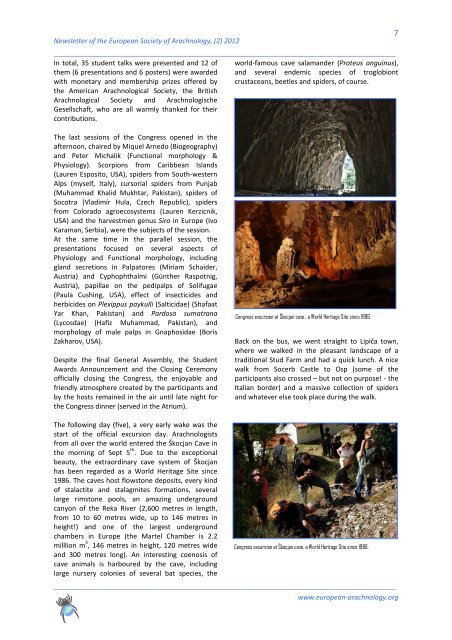Newsletter 2 - European Society of Arachnology
Newsletter 2 - European Society of Arachnology
Newsletter 2 - European Society of Arachnology
You also want an ePaper? Increase the reach of your titles
YUMPU automatically turns print PDFs into web optimized ePapers that Google loves.
<strong>Newsletter</strong> <strong>of</strong> the <strong>European</strong> <strong>Society</strong> <strong>of</strong> <strong>Arachnology</strong>, (2) 2012<br />
___________________________________________________________________________<br />
In total, 35 student talks were presented and 12 <strong>of</strong><br />
them (6 presentations and 6 posters) were awarded<br />
with monetary and membership prizes <strong>of</strong>fered by<br />
the American Arachnological <strong>Society</strong>, the British<br />
Arachnological <strong>Society</strong> and Arachnologische<br />
Gesellschaft, who are all warmly thanked for their<br />
contributions.<br />
The last sessions <strong>of</strong> the Congress opened in the<br />
afternoon, chaired by Miquel Arnedo (Biogeography)<br />
and Peter Michalik (Functional morphology &<br />
Physiology). Scorpions from Caribbean Islands<br />
(Lauren Esposito, USA), spiders from South-western<br />
Alps (myself, Italy), cursorial spiders from Punjab<br />
(Muhammad Khalid Mukhtar, Pakistan), spiders <strong>of</strong><br />
Socotra (Vladimír Hula, Czech Republic), spiders<br />
from Colorado agroecosystems (Lauren Kerzicnik,<br />
USA) and the harvestmen genus Siro in Europe (Ivo<br />
Karaman, Serbia), were the subjects <strong>of</strong> the session.<br />
At the same time in the parallel session, the<br />
presentations focused on several aspects <strong>of</strong><br />
Physiology and Functional morphology, including<br />
gland secretions in Palpatores (Miriam Schaider,<br />
Austria) and Cyphophthalmi (Günther Raspotnig,<br />
Austria), papillae on the pedipalps <strong>of</strong> Solifugae<br />
(Paula Cushing, USA), effect <strong>of</strong> insecticides and<br />
herbicides on Plexippus paykulli (Salticidae) (Shafaat<br />
Yar Khan, Pakistan) and Pardosa sumatrana<br />
(Lycosdae) (Hafiz Muhammad, Pakistan), and<br />
morphology <strong>of</strong> male palps in Gnaphosidae (Boris<br />
Zakharov, USA).<br />
Despite the final General Assembly, the Student<br />
Awards Announcement and the Closing Ceremony<br />
<strong>of</strong>ficially closing the Congress, the enjoyable and<br />
friendly atmosphere created by the participants and<br />
by the hosts remained in the air until late night for<br />
the Congress dinner (served in the Atrium).<br />
The following day (five), a very early wake was the<br />
start <strong>of</strong> the <strong>of</strong>ficial excursion day. Arachnologists<br />
from all over the world entered the Škocjan Cave in<br />
the morning <strong>of</strong> Sept 5 th . Due to the exceptional<br />
beauty, the extraordinary cave system <strong>of</strong> Škocjan<br />
has been regarded as a World Heritage Site since<br />
1986. The caves host flowstone deposits, every kind<br />
<strong>of</strong> stalactite and stalagmites formations, several<br />
large rimstone pools, an amazing underground<br />
canyon <strong>of</strong> the Reka River (2,600 metres in length,<br />
from 10 to 60 metres wide, up to 146 metres in<br />
height!) and one <strong>of</strong> the largest underground<br />
chambers in Europe (the Martel Chamber is 2.2<br />
milllion m 3 , 146 metres in height, 120 metres wide<br />
and 300 metres long). An interesting coenosis <strong>of</strong><br />
cave animals is harboured by the cave, including<br />
large nursery colonies <strong>of</strong> several bat species, the<br />
world-famous cave salamander (Proteus anguinus),<br />
and several endemic species <strong>of</strong> troglobiont<br />
crustaceans, beetles and spiders, <strong>of</strong> course.<br />
Congress excursion at Škocjan cave,, a World Heritage Site since 1986.<br />
Back on the bus, we went straight to Lipiča town,<br />
where we walked in the pleasant landscape <strong>of</strong> a<br />
traditional Stud Farm and had a quick lunch. A nice<br />
walk from Socerb Castle to Osp (some <strong>of</strong> the<br />
participants also crossed – but not on purpose! - the<br />
Italian border) and a massive collection <strong>of</strong> spiders<br />
and whatever else took place during the walk.<br />
Congress excursion at Škocjan cave, a World Heritage Site since 1986.<br />
_______________________________________________________________________<br />
www.european-arachnology.org<br />
7
















